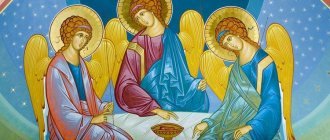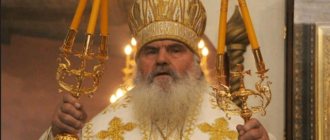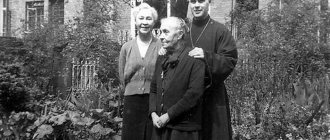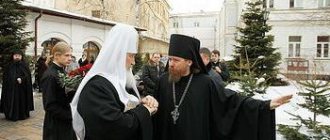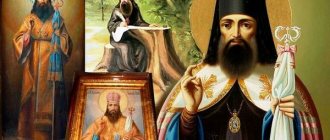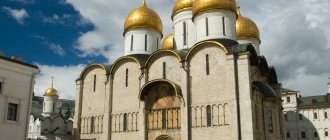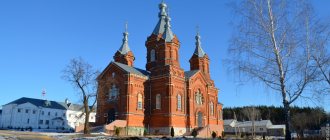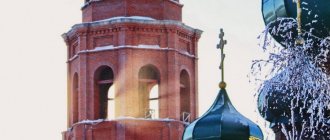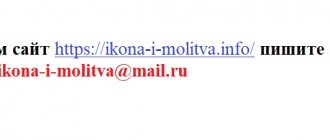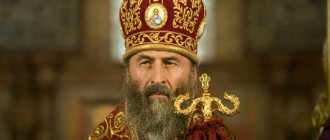I am not your “kiss-kit,” but the Lord. What is the secret of the popularity of Metropolitan Tikhon’s cat?
Vladyka is the most famous cat in the Pskov region. His “possessions” are the entire Pskov-Pechora Monastery, one of the largest and oldest monasteries in Russia. Unlike the “learned” literary character, the Lord does not have an oak tree with a golden chain, he does not start a song and does not tell a fairy tale. But on his Instagram there are almost 16.5 thousand subscribers, and their number is growing every day. Each cat blogger's post gets thousands of likes and hundreds of comments.
The fluffy handsome man lives with his owner, also a bishop - Metropolitan of Pskov and Porkhov Tikhon (Shevkunov). Many people call the cat amazing and dream of seeing it in person.
No allergies
The cat Vladyka appeared at the monastery about a year ago - then he was given to the Metropolitan as a one-year-old teenager. Since then, the red Maine Coon has become Vladika Tikhon’s constant companion. Almost no monastic meeting can take place without it: it is allowed to lie on the table among important papers or bask in the bishop’s chair. The cat meets his owner after church services or business trips. And this despite the fact that Bishop Tikhon is allergic to cats. On everyone except the Lord.
“When the ruler works, the cat always lies nearby. Fortunately, it turns out that Maine Coons have hypoallergenic coats. By character, as Vladyka Tikhon says, the cat is more serious than himself. He is observant - he loves to lie on the balcony and watch what is happening on Assumption Square. Vladyka Tikhon takes his red-haired friend on work trips. Once he even flew with his owner to Moscow by plane and, surprisingly, behaved very calmly. Maine Coons are very friendly and loyal,” said Metropolitan Tikhon’s secretary, Father Anthony. Together with cell attendant Kirill, they maintain a blog for the monastery cat.
A photo of a cat thoughtfully looking out the window caused a flurry of comments and likes among Instagram followers. And this is not surprising - it’s not every day that cats go on a business trip.
But photos with both rulers still enjoy greater popularity - commentators even claim that the pet is very similar to its owner. And they are also surprised by the stories about how the cat chose his nickname.
“Many people ask why the cat was named that way? And we have nothing to do with it, he chose this name for himself. Vladyka Tikhon tried to call him a Novice, but the red-haired man did not even move at this call. Then the cell attendant, the vicar and others followed - also to no avail. And he doesn’t even respond to “kiss-kit,” but he responded to Vladyka immediately,” says Father Anthony.
Costs of popularity
The monastery calls not only the cat itself amazing, but also its popularity on the Internet. After each publication - several hundred new subscribers. The red pet's DM is literally inundated with messages.
“The number of subscribers is increasing rapidly, this is generally some kind of unrealistic growth, I have never seen anything like this. Yesterday I posted a publication, 300-400 people were added within 24 hours. In six months, the number of subscribers has tripled,” Father Anthony shares his impressions.
One day, the monastery decided to check the activity of subscribers and suggested asking questions in Stories. In less than a day, a flurry of messages fell on the cat’s “personal” page.
“They asked everything: how and how to help, what he eats, where he sleeps, whether everything is fine with him, why there were no publications for a long time. And different messages - from laudatory, incredible praises to pragmatic things. You can spend hours looking through direct messages - we don’t ignore anyone, we answer everyone. After that, I stopped making such news feeds,” explains Father Anthony.
The popularity of the monastery cat has already reached the point that his fake accounts have begun to appear on the Internet.
“There are pages where the content is harmless, no big deal. But if they collect money from accounts, then, of course, we complain and ask them to block them,” says Father Anthony.
To surprise the audience, Vladyka literally does not spare his paws: he has already visited the entire territory of the monastery, even where even the brethren usually do not look.
“We also looked into the cowshed to get acquainted with the little goats, and on Maslenitsa we visited the fair near the walls of the monastery. Then Vladyka rode on a camel,” says cell attendant Kirill. “On Holy Hill, we showed the roof of the Assumption Church to subscribers and introduced them to the clock mechanism of the chimes in the belfry,” says cell attendant Kirill.
Extend the paw of friendship
The cat Vladyka is not indifferent, he understands that not all of his brothers live in the abbot’s chambers. Recently he received a letter from the cat Malyshka from the Pskov shelter for homeless animals “Lesopilka”, in which she talked about her life and asked for help. Of course, Vladyka did not ignore her request and turned to his subscribers with a request for all possible help.
“We gladly respond to such requests, but we do not agree to offers to advertise something. And it was joyful to learn from the representatives of the shelter that help came from our subscribers! For which we, together with the cat, thank them,” says Father Anthony.
Vladyka has many friends in other regions of Russia. Recently he flew to Moscow to visit his friend, a dachshund named Donna Rosa. She has a responsible job - guarding the Patriarchal Council for Culture, the head of which is Metropolitan Tikhon. The Pechora instablogger also managed to make friends with Mostik, the most famous cat in Russia.
“We had joint publications with the cat Mostik, who participated in the construction of the Crimean Bridge and acts as the press secretary of Crimea. He noticed our account and contacted us with an offer,” recalls Father Anthony.
Floral flavors and no meat
The Lord is a kind of cat intellectual: he will either put a red bow tie around his neck, or replace it with a stylish tie.
“He himself is very charismatic. And any of his poses can just paint pictures. And he will lie down, and look, and turn around. There is no need to ask him specifically for any angles - he sits down himself like a real model. Basically, the photographs are more relaxed, natural, of course,” says Father Anthony.
In the cool season, the furry inhabitant of the monastery wraps himself in a warm blanket, and in the spring he enjoys the aroma of flowers. And not just any kind - he chooses exclusively exquisite varieties.
“He is very sensitive, loves smells - he especially likes rose and lily of the valley. He often lingers on the bishop's balcony. It can stand up on its hind legs and sniff. He’s generally not indifferent to smells,” says cell attendant Kirill.
But, if necessary, the cat can “show his character.”
“He knows how to stand up for himself. He himself is very humble, he will never be the first to climb. But if you start to find fault with him, he will fight back. It’s interesting how he asks for food: he goes to his cup, sits down and just looks at it silently. In the morning, he jumps on the table, comes up to the tap and hints that it needs to be turned on,” continues the cell attendant.
The Lord also watches his figure and strictly observes fasting - he practically does not eat meat, preferring plant foods.
“Initially they tried to feed him meat, but he showed himself to be a great faster - Lent was just beginning. And a paradoxical moment - there were sprouted oats next to his plate, and he gradually gave it preference, and stopped eating meat. And now we have switched him to special food,” explains Kirill.
The cat is also very selective when communicating with people. With the brethren he is reserved and patient. Be careful with strangers. In a word, the character is Nordic. He only has warm relations with the Metropolitan himself. With him, as they say, he is submission itself.
“Once again the cat went to the balcony and smelled flowers. After the service, Vladyka Tikhon came for him and called: “Prodigal son, come back to the house!” The cat meowed and immediately ran home. He constantly meets the bishop: the bishop enters the building, he immediately runs out to meet him,” cell attendant Kirill shares his observations.
The cat invites you to visit
Vladyka lives practically in the very center of the Pskov-Pechora Monastery - in the house of the abbot of the monastery. Walking past this cozy green three-story building, thousands of pilgrims from all over the world have no idea that this is where the residence of the popular feline intellectual is located.
From here it is literally a stone's throw to the entrance to one of the main shrines of the monastery - the caves created by God, a unique complex of karst underground galleries and streets with the cave Church of the Resurrection of Christ. Here, underground, is the monastery cemetery. The exact number of burials is unknown, but, according to rough estimates, more than 10 thousand people are buried in them.
“It is likely that some subscribers to the account did not know about our monastery, but now they will want to come and get to know its history better. Children’s drawings are sent to us via direct message, where our cat is depicted against the backdrop of the monastery, this is very nice,” says Father Anthony.
Territory of the Holy Dormition Pskov-Pechora Monastery. On the right is the house of the governor of the monastery, where the cat Vladyka lives. Photo: Alexey Semenov/TASS
The main task of the account, Father Anthony formulates, is to fill it with meaning and engage in charity. Create light content, cover in a simple form the life of the monastery, events related to the monastery.
“We have an official account of the monastery with serious information, and the account of the Vladyka’s cat is for telling about the monastery to a wider circle of people. Of course, we will continue to support charitable projects,” adds Father Anthony.
The monastery ensemble includes more than ten ancient temples. The cat is not allowed to enter there - this is perhaps the only prohibition that applies to him.
“Although cats are considered “clean” animals, this is known from the Old Testament, they are even allowed into the altar, because they catch rodents, but the Vladyka cat is still not allowed into the temple,” says Father Anthony.
But he happily acts as the monastery’s press secretary: he talks about important church holidays, inspects the fair on the monastery square and shares his impressions about it. And of course, he invites everyone to the monastery. At the beginning of spring, the handsome red-haired man invited guests to Maslenitsa: he offered to taste the monastery sour cream, ride a camel, and even advised how best to get to Pechory - by plane or by Lastochka.
“Vladyka Tikhon also actively takes part in filling the account, sending us his photos and videos, because he spends the most time with his pet,” Father Anthony concludes the conversation, setting off to think about new topics and tasks for the feline Internet star.
Patron saints of animals
Each type of farm animal has its own heavenly patron. In Orthodoxy, there are many saints who are considered patrons of animals. In Russia, right up to the 20th century, on the day of the Hieromartyr Athenogenes (July 29, New Art), peasants brought animals (livestock) to the church, where a special order was read over them for their multiplication and health. Therefore sschmch. Afinogen was considered the patron saint of livestock.
Among the Orthodox, there are many prayer books about animals - companions and helpers of man - a prayer for the blessing of the beekeeper, for the protection of flocks and shepherds, a prayer for the death of livestock, for the protection of cattle, for the protection of sheep, horses, pigs, geese and other waterfowl, prayer about the multiplication of a swarm of bees.
Over the centuries, Orthodoxy has gradually developed a tradition of turning to a certain saint for help when problems arise in certain branches of animal husbandry. So it is believed that Saint Blaise helps cattle breeders - pig breeders, Saints Flor and Laurus - horse breeders, Saint Nikita - those who raise waterfowl, etc.
even turn to St. George the Victorious to protect their livestock from theft and wild animals. Almost all animals that have taken root near humans (with the exception of cats and dogs) have chosen heavenly patrons. Moreover, there is a special “prayer rite during the destructive pestilence of cattle.” From time immemorial, when there was such a misfortune, the peasants invited the priest “where the cattle are sick,” and the priest, putting on an epitrachelion, performed a prayer service over the sick cattle, after which he sprinkled holy water on the animals themselves and the hay used as food for the livestock.
According to legend, Saint Agafya, the martyr (patron of livestock), contributed to the successful calving of cows, and Onesimus the Shepherd (February 15, old style) protected sheep in sheepfolds from wolves.
to Saint Modest of Jerusalem (December 31), the patron saint of domestic animals, for his well-being and health. The Venerable Martyr Anastasia of Rome is a helper in the preservation, welfare and healing of livestock.
| From the lives of Christian saints it is known that many of them treated “our lesser brothers” with great love. On icons with hagiographic pictures of St. Sergius of Radonezh and Seraphim of Sarov, wild animals are often placed, which the saints fed from their hands, and on the icon of St. Gerasim of Jordan they always depict a lion sitting at his feet. Tradition says that this lion served the monk as a pet as a sign of gratitude for his cure from a painful abscess. |
It is also necessary to remember St. Maximus the Confessor , St. Gerasim of Jordan , the martyr Mamant the patron saint of small cattle - sheep and especially goats, the holy martyr Tryphon , the patron saint of birds, St. John of Rila, as well as Anthony the Great who helped the little animals...
It is firmly entrenched in the popular consciousness that someone who does not love animals can hardly sincerely love people, and in the Orthodox press, dedicated to relationships with the animal world, they often use the expression “Blessed is he who has mercy on cattle,” which is a free translation of the biblical Church Slavonic text: “A righteous man has mercy on the souls of his beasts” (Proverbs chapter 12, verse 10). The meaning of this expression is interpreted by some theologians as follows: at the Last Judgment, God will ask a person for his attitude towards animals.
We will be grateful if you share this page on social networks
